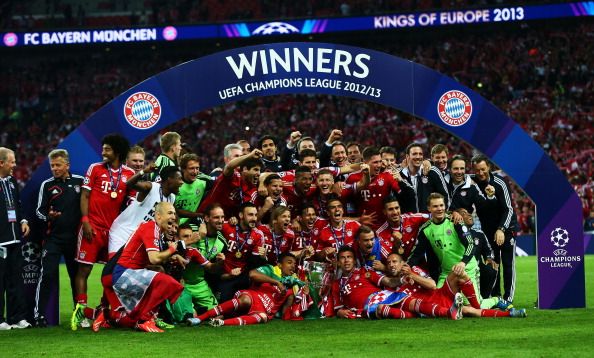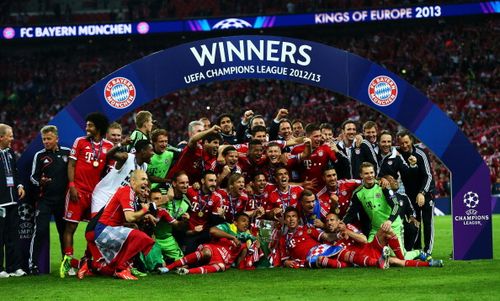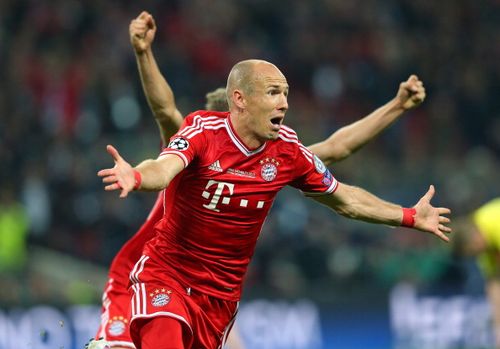
Champions League Final - Bayern Munich 2-1 Borussia Dortmund: Tactical Review

The Bayern Munich team poses with the trophy after winning the UEFA Champions League final match against Borussia Dortmund at Wembley Stadium on May 25, 2013 in London, United Kingdom. (Getty Images)
Bayern Munich broke the curse of cruel Champions League Final exits by beating Borussia Dortmund at Wembley 2-1. But more importantly, it was Arjen Robben’s break from a similar curse which had seen him collect widespread taunts even during this game, in spite of putting a spirited performance throughout. Though this has been Bayern’s well deserved moment, Dortmund’s performance at Wembley definitely steals some of the thunder.
Jupp Heynckes named a team similar to the one expected, in spite of Bastian Schweinsteiger suffering a late injury scare in warm up. A 4-2-3-1 was completed by Thomas Muller and Mario Mandzukic upfront, with Robben and Franck Ribery on the wings.
Jurgen Klopp had to make the huge decision of whom to use in place of Mario Gotze, and the manager stood with Marco Reus in the centre even though Ilkay Gundogan as being widely preferred for the role, who instead slotted in as a pivot with Sven Bender.
This game was turning out to be a one-sided affair in the first half with Dortmund’s pressing in midfield dominating Heynckes’ men. Javi Martinez’s eventual return to a deeper position and Robben’s cut-ins between the Dortmund centre-backs finally turned the game in the favour of the German champions.
Bayern’s midfield duo’s early struggles
Even though Bayern Munich and Dortmund know each other’s styles pretty well, Heynckes’ initial tactics played right into Dortmund’s hands. Bayern started with Schweinsteiger playing in an extremely deep role right away. So Dortmund’s midfield especially Reus immediately started to close him down at the centre of defence and this directly resulted in the experienced German to choose a pass to the adjoining centre-backs rather than more ambitious ones.
While Dortmund were able to close down Bayern’s midfield easily due to Schweinsteiger positioning, another factor that led to such an utter domination by Klopp’s men was Martinez’s position. The big Spaniard was played as a deep midfielder against Barca and was used to mark Iniesta. But here, supposedly due to the lack of height and physicality in Dortmund’s midfield duo of Bender and Gundogan, Martinez was instructed to press up in attack.
So the long gap between both of Bayern’s midfielders was expertly closed down by Dortmund’s front men. A factor that came into play here importantly was that how little Muller was offering in midfield. Though Muller later on moved to the right side of attack, the German striker started the game at No.10 but rarely offered any support to his midfield. Heynckes missed the injured Kroos who could have made up the numbers needed in the centre and could have thus resolved the ‘pressing’ issue.
Bender and Gundogan win midfield battle
Dortmund’s pressing was mainly carried out due to Robert Lewandowski’s deeper position. This left Reus as the furthest man upfront at times, and the German was able to control the game from there. He and Lewandowski along with Kuba on the right kept making dangerous triangles in front of Bayern’s defence.
With the front 3 closing down and attacking well, the duo of Gundogan and Bender were equally good off the ball. Bender was trusted with the duty of covering Martinez, and though the German left the Spaniard to run couple of times when Bayern attacked, Bender was effective in closing down Martinez deep in Bayern’s half where the Spaniard went to receive the ball.
Gundogan in the Madrid game was given the role to close down Luka Modric’s ventures into his half. But on this occasion he was given the job to close Schweinsteiger down quickly, and due to Bastian’s deep-lying role, Gundogan did not have much to do initially. But as the game progressed he made sure he closed him down.
Dortmund lacks a distributer, Subotic steps up finally
One look at the Dortmund team shows that Nuri Sahin’s absence from the centre meant that there was no distributer in midfielder. Pre-match assumptions that Mats Hummels would carry out this role dangerously were proven right as the German defender fearlessly stepped out of defence to either carry out the ball or play a long pass. In fact the game followed a pattern in the first 20 minutes, as Bayern’s centre-backs Dante, Boatang and even Schweinsteiger were looking for long aerial balls for Muller and Mandzukic, while Dortmund’s pair of Neven Subotic and Hummels were composed enough to win everything in the air and then play grounded balls to either Lewandowski or Reus who could then flick it on to the other runner.
Subotic on more than one occasion was highly impressive, and his last-ditch tackle saved a tap in against Robben. The Serbian has often been seen in Hummels’ shadow, but now the German’s more prevalent errors are quite visible and when Subotic puts in a performance full of strength and composure like this one, the comparisons quite vary.
Both teams were threatening from set-pieces, but Dortmund’s woeful defending at such instances almost allowed 2 goals for Bayern. Both the goalkeepers were also at the top of their games, especially Roman Weidenfeller, who put in a top notch performance.

Arjen Robben celebrates after scoring the winning goal during the UEFA Champions League final between Borussia Dortmund and Bayern Munich at Wembley Stadium on May 25, 2013 in London, United Kingdom. (Getty Images)
Robben steals the show
Robben looked to be Bayern’s most evident threat. The Dutch winger missed 3 good chances in the first half, but he was also getting into decent positions out wide and he even set up the opener. One main flaw in Dortmund’s game, which allowed Robben all the freedom was Marcel Schmelzer’s lack of positional discipline at left-back.
Dortmund started to play much more from the back in the 2nd half, and Gundogan started taking deeper positions in the defence and hereby pushing the duo of Hummels and Subotic apart. The Dutch winger targeted the space created between the now wide centr- backs. A similar approach saw a long ball arrive from the defence to Ribery who stuck to Gundogan in the centre, and his flick onto Robben saw the Dutchman wriggle through the wide defenders before scoring the winner.
Neither manager had made any change before the winning goal went in, and now there were a flurry of changes at the death which didn’t affect the score line.
Klopp obviously deserves credit for his tactics and team’s performance at Wembley but this game was won purely on the speed and guile of Robben.